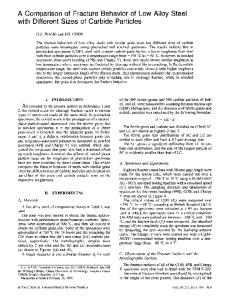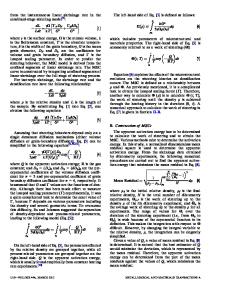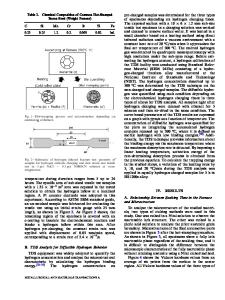Effects of loading rate on fracture behavior of low-alloy steel with different grain sizes
- PDF / 524,319 Bytes
- 14 Pages / 606.24 x 786 pts Page_size
- 22 Downloads / 348 Views
6/5/04
7:54
Page 1765
Effects of Loading Rate on Fracture Behavior of Low-Alloy Steel with Different Grain Sizes G.Z. WANG, X.C. REN, and J.H. CHEN Four-point bend (4PB) tests of notched specimens loaded at various loading rates, for low alloy steel with different grain sizes, were done, and the microscopic observation and finite-element method (FEM) calculations were carried out. It was found that for the coarse-grained (CG) microstructure, an appreciable drop in notch toughness with a loading rate of around 60 mm/min appeared, and further increasing the loading rate leads to a slight additional decrease in notch toughness. For the finegrained (FG) microstructure, the effect of loading rate was not apparent. The change in toughness resulted from a change of the critical event controlling the cleavage fracture with increasing loading rate. For the CG microstructure with a lower cleavage-fracture stress (f), with an increasing loading rate, the critical event of cleavage fracture can be changed from the propagation of a pearlite colony–sized crack or a ferrite grain–sized crack, through the mixed critical events of crack propagation and crack nucleation, then to crack nucleation. This change deteriorates the toughness. For the FG microstructure with a higher cleavage-fracture stress, the critical event of cleavage fracture is the crack propagation and does not change in the loading-rate range from 120 to 500 mm/min. The measured f values do not change with loading rate, as long as the critical event of cleavage fracture does not change. The higher notch toughness of the FG microstructure arises from its higher f and the critical plastic strain (pc) for initiating a crack nucleus, and the fracture behavior of this FG steel is not sensitive to loading rate in the range of this work.
I.
INTRODUCTION
IT is well known that changes in loading rate and test temperature influence the deformation (yield and flow) and fracture behavior of steel. The most significant effect of increasing loading rate is to shift the quasi-static Klc transition curve toward higher temperatures, that is, to raise the temperatures at which cleavage may occur.[1] This is very critical for structural steel components. The high-strain-rate sensitivity of these steels makes the safety design on the basis of quasi-static behavior rather poor. Therefore, the reliability of structures possibly loaded at higher loading rates requires the knowledge of the corresponding material fracture behavior. Couque et al.[2] investigated the fracture behavior of a plain-carbon steel with various microstructures at two loading rates corresponding to quasi-static and high-rate loading (Charpy impact test) and over a range of temperatures. The effects of temperature, loading rate, and various microstructural parameters on the initiation of plane-strain fracture were explored. Zurek et al.[3] studied the influence of dynamic spall loading on the cleavage-fracture behavior of a mildcarbon steel. Lee et al.[4] characterized fracture toughness under both dynamic a
Data Loading...











